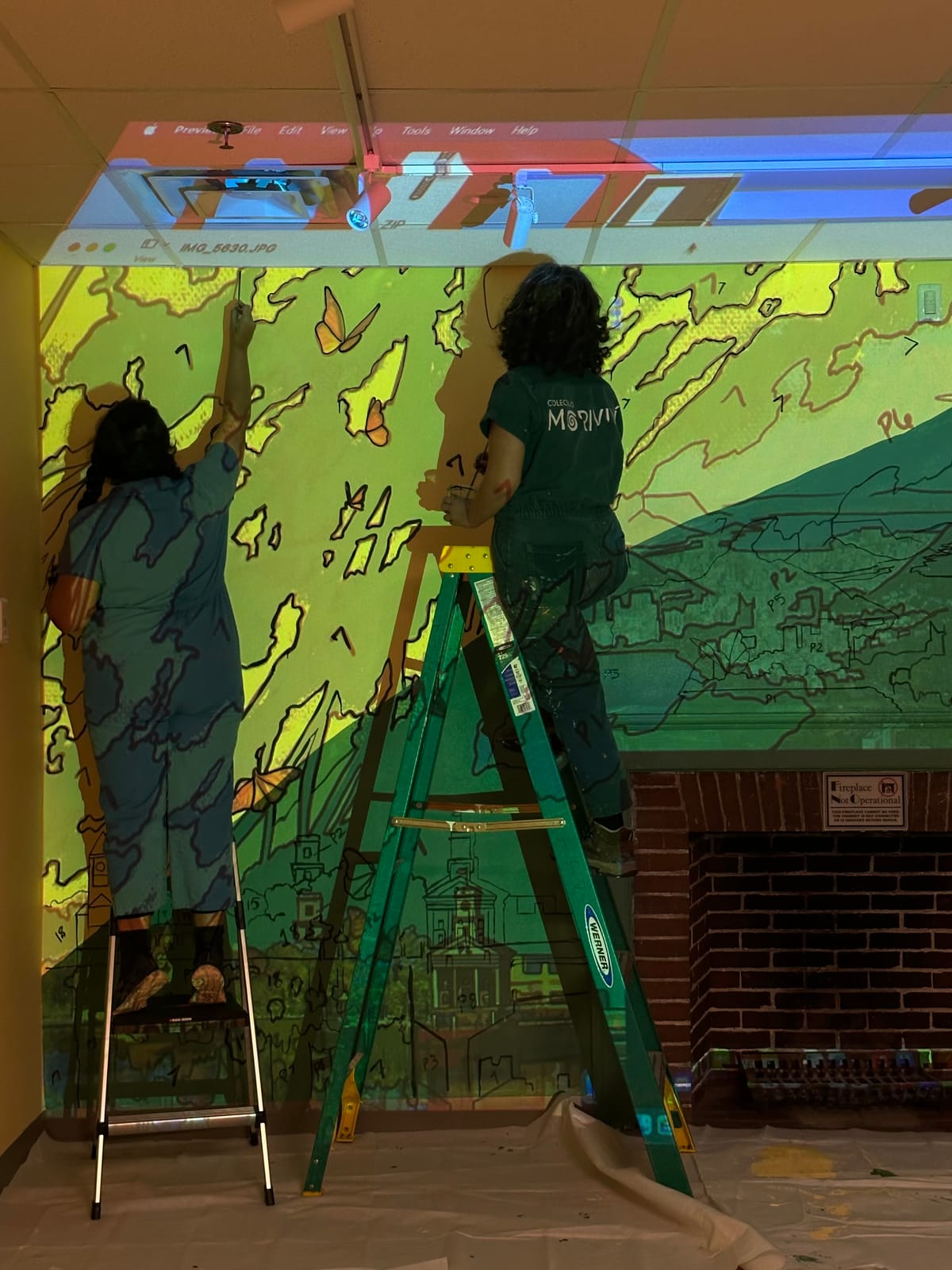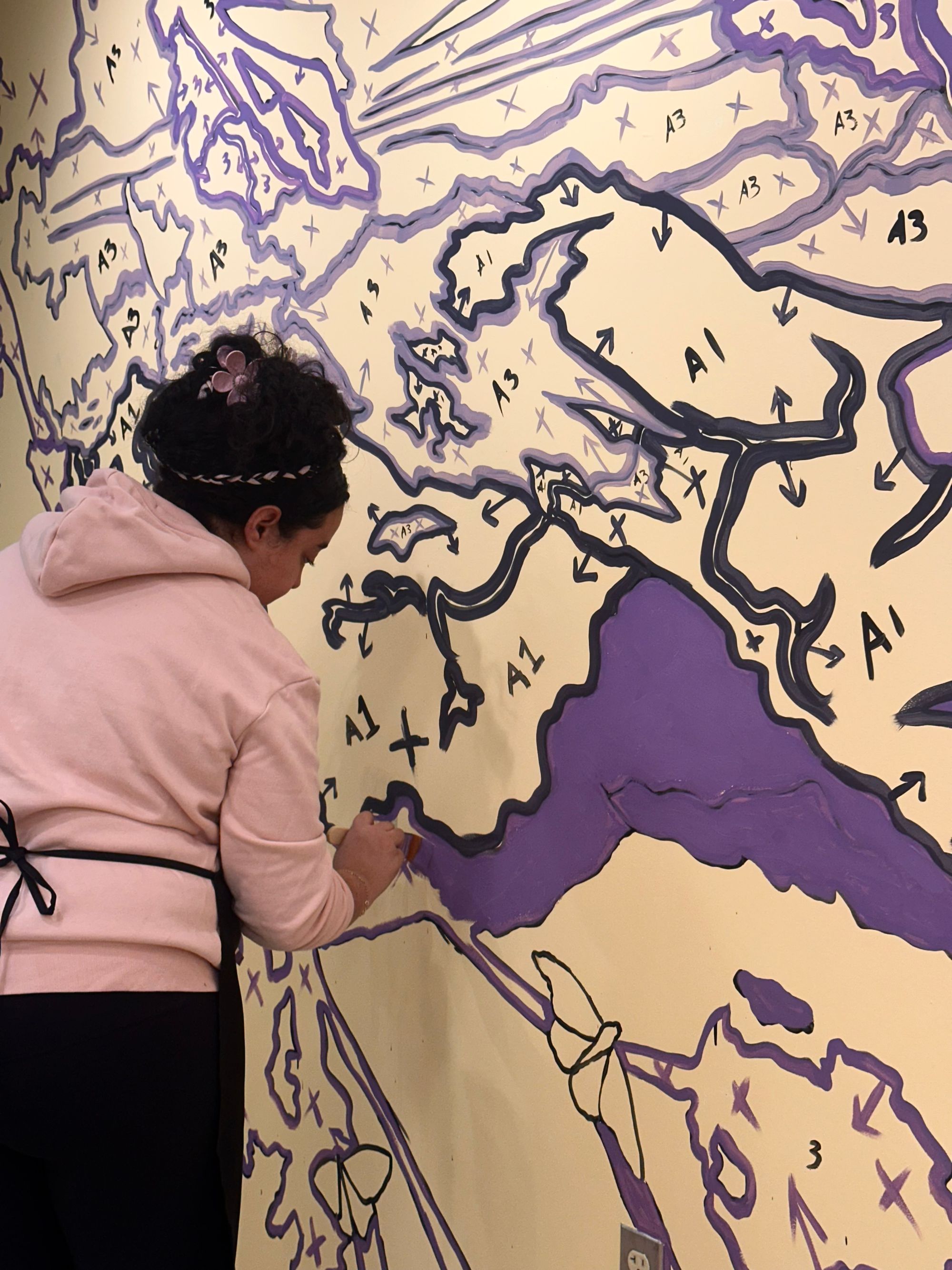Mural Breathes New Life into Newport Lounge
Arts & Living Managing Editor Sarah Weiner ’24 highlights Newport’s new mural located in the basement lounge, which reaffirms an appreciation for Latinx identities and collaboration on Amherst’s campus.

When Piero Campos ’25, Armando Garcia ’25, and Amelie Justo-Sainz ’25 arrived on campus in the fall of 2021, they were eager to join what they hoped would be a vibrant Latinx community on campus — and were then disappointed to find that one barely existed. In continued pursuit of their goal, the three moved to La Casa, campus’ Latinx culture house, their sophomore year. Despite La Casa being a space dedicated to the celebration and expression of Latinx culture, they found little “sense of community,” Campos said.
Motivated by these frustrations as well as the deteriorating living conditions in Newport Hall, where La Casa is located, Campos, Garcia, and Justo-Sainz took the matter into their own hands. Last summer the group approached Professor of Spanish Paul Schroeder Rodriguez, La Casa’s unofficial faculty liaison at the time, to ask for help in reviving the spirit of the Latinx theme house. Campos also credited Josue Martin ’24 and Kevin Gutierrez ’24 with the beginnings of the collaboration even though they couldn’t see it through. “Our upperclassmen were already thinking about it [the mural],” Campos said. “It’s nice to have it passed down to us too.”
This evening, almost one year later, one of the products of their conversations will be revealed on the walls of Newport’s basement lounge: A mural designed and painted by Colectivo Moriviví, an all-women artistic collective based in Puerto Rico, in collaboration with the residents of Newport. Schroeder Rodriguez secured funding for the project from the Spanish Department, the Latinx & Latin American Studies Department, the Center for Community Engagement, Student Affairs, and the Office of the President.
Moriviví first grabbed Schroeder Rodriguez’s attention with one of their murals located in the Community Room of the Holyoke Public Library. (As of 2010, Holyoke has the largest per capita Puerto Rican population of any city in the U.S outside of Puerto Rico.) The collective, co-founded in 2013 by Sharon “Chachi” González Colón and Raysa Raquel Rodríguez García, has produced murals and community projects across Puerto Rico and in several cities across the Puerto Rican diaspora, including Holyoke. Moriviví has a notable footprint across the Pioneer Valley: The artists have spoken at University of Massachusetts Amherst in addition to completing murals in Holyoke, Springfield, and now in Amherst.
Although Newport’s basement was already home to a mural, its condition was deteriorating, and more importantly its design did not resonate with all of Newport’s residents. It was commonly critiqued by residents for primarily representing Mexican culture as opposed to all Latinx identities.
The new mural, reaching from floor to ceiling and spanning three walls, was designed with the concept of pan-latinidad — the coexistence and unity of diverse Latin American identities — in mind. Residents of La Casa met virtually with Colón and García four times during the fall semester to engage in creative and brainstorming activities to generate ideas about what they wanted to see in the mural. The need for reviving a sense of Latinx community on campus was especially evident in the small size of the meetings.
“It was kind of hard to have a big turnout,” Justo-Sainz said. “We tried advertising it with La Causa [a student-run Latinx political, cultural, and service organization] and the La Causa group chat, but it was mostly just the three of us [Justo-Sainz, Campos, and Garcia] that would attend the workshops.”
The artwork’s deliberate details reflect the success of these meetings and the brilliance of Colectivo Moriviví. Every small detail entices, and the warm palette of 55 colors embraces residents and visitors as they enter the space. The artwork contains clearly identifiable scenes from Amherst, Holyoke, and various Latin American countries including Brazil, Mexico, Puerto Rico, and Peru, as well as more representative imagery like poster boards to evoke the history of Latinx activism on campus, inverted world maps to honor Indigenous traditions, and even a few butterflies to honor the legacy of the old mural.
Campos said the mural aims to capture “the collision of the two worlds that are relevant to our Latinx identity.” This principle is expressed visually in the mural as well as through words. One prominent section of the work features a poem in Spanish and English that was written by the students of Senior Lecturer in Spanish Carmen Granda’s course “Finding Your Bilingual Voice.”
Colón and García shared with The Student a similar appreciation for the range of identities shown in the artwork. Most of Moriviví’s projects in the United States have been collaborations with specifically Puerto Rican diaspora communities; the Newport mural’s representation of many different Latinx communities is a distinctive opportunity for the artists to hear and share experiences with other Latin Americans.
Regarding this intercultural exchange, García said: “The relationship that we have with the United States sometimes takes away from the opportunity of having these relationships with Latin America … doing this work in the U.S. feels, perhaps in an indirect way because we are in the diaspora with other latines, like we are creating important connections, even though we aren’t physically in Latin America.”

What is incredible about the collective’s artistry is that these connections are not merely represented visually in the art, but literally in the collaborative painting process they facilitated. Students, staff, and faculty connected to Latinx and Spanish speaking communities signed up for painting slots offered on a few days of last week. Greeted warmly by García and Colón and project assistants Gabriela Díaz Ortíz and Patrica Victoria Rivera Vega, a long table of paint-filled deli containers, and an energetic mix of Spanish and English music, we donned aprons and were put to work one color at a time, filling in shapes in a paint-by-numbers-esque system.
“The most rewarding part,” Colón said, “truly is seeing the final result. Also seeing people see their ideas represented visually and succeeding in that way is always really rewarding. It always surprises people that we find a way to incorporate all of their ideas.”
The residents of Newport hope that the new artwork will rekindle life and community in the space. The mural is part of a bigger project to “make sure that people remember what Newport is supposed to be like and why it was created in the first place — to be a safe space for the Latinx community,” Justo-Sainz said. She happily added that based on applications to La Casa this year, they will be able to increase room occupancies from eight to an estimated 22.
“We want us to be in charge of our own history,” Garcia said. “We want to tell the story for what it is, what we experience, and what our own people experienced in the past, and how people have come through Amherst. We want to make sure to leave that mark, that they know we were here, we made this happen, and that others are inspired to do the same thing in the future.”


Comments ()